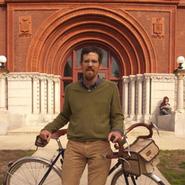
As Hamilton prepares for its new bike path, cultural anthropologist Luis Vivanco’s lecture, “Reconsidering the Bicycle,” could not be more timely. Vivanco, director of the Global and Regional Studies Program and founding director of the Global Studies Program at the University of Vermont, spoke about the current global state of using bikes as alternative transportation. The Levitt Center sponsored the event on Oct. 24.
As an avid cyclist himself, Vivanco’s daily habit of riding has developed into a fascination with the culture surrounding bicycles, both former and current. Since the advent of the bike, conflicting opinions about their worth and position in society have been expressed. Originally made popular by elite gentlemen at the close of the nineteenth century, Wheelmen’s Clubs offered fraternal opportunities and a deliverance from the bustle of city life to the untainted, pastoral landscapes reminiscent of a simpler time.
Vivanco explained that as the auto industry in America began to boom and the suburbs began to sprawl, bicycles lost their aristocratic status and became a children’s toy. As the 20th century progressed, cycling remained a “lost art” until the oil embargo of 1976, beginning the wave of eco-politics and sustainable transportation that are flourishing today.
Despite the advantages for personal health, the global ecosystem and one’s wallet, sustainable transportation in the United States is not as popular as its European counterparts. Vivanco cites geographic, jurisdictive and climatic factors to explain how the compact nature of European cities and government-sponsored infrastructure helps to foster a strong riding culture. An effort to mimic this in the States, so called “Copenhagenization,” remains a slow process. Yet, bicycle commuting in the US has risen 61 percent since 2001, and 21 bicycle-sharing programs now exist in more than a dozen American cities.
While health benefits remain a large factor in cycling’s increasing popularity, Vivanco explains that ecological citizenship, taking personal responsibility to decrease harmful impacts on the environment, has been the driving force behind the movement. At the administrative level, cities are dealing with increasing congestion and competition to attract tourists, leading to the installation of cycling lanes and the reallocation of former railroads to scenic bike paths. The aptly named “greenways” are becoming more popular and hundreds of miles of trails are added annually.
Vivanco ended with a reflection on the meaning of the bike. While it is no longer just a toy for children, a tool for athletes, or a symbol for political activism, Vivanco asserts that the bike has adapted a niche for everyday mundane transportation. He makes the clarification that mundane, which comes from the Latin mundus, meaning “of or pertaining to the earth,” is not a criticism. Rather it serves to highlight the prevalent, ecological undertones of the lost art of cycling.
Posted October 25, 2013
